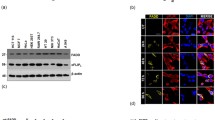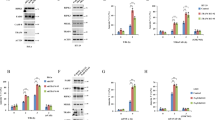Abstract
Tumor necrosis factor-related apoptosis inducing ligand (TRAIL/APO-2L) activates nuclear factor κB (NFκB). This activation is regulated by the recruitment of an adaptor protein Fas associating death domain (FADD) to TRAIL death receptors, death receptor 4 (DR4, TRAIL-R1) and death receptor 5 (DR5 TRAIL-R2). This leads to recruitment of caspase 8 and receptor interacting protein (RIP) to the receptor complex. Upon recruitment of caspase 8 and RIP, NFκB inducing kinase (NIK) becomes activated causing NFκB activation. The role of TRAIL induced NFκB activation in epithelial cells is unknown. Herein we demonstrate that TRAIL increases expression of DR5 in human embryonic kidney (HEK) 293, MCF-7 and MDA MB 231 epithelial cell lines while DR4 expression remains unchanged. Blockage of NFκB activation either by expression of dominant negative IκB or treatment with proteasome inhibitor lactacystin eliminates TRAIL induced DR5 expression. Expression of FADD dominant negative in HEK 293 cells that prevents the recruitment of caspase 8 and RIP to TRAIL death receptors also eliminates this increase. By over expression of the p65 subunit of NFκB that increases NFκB transcriptional activity, DR5 expression was increased compared to vector alone expressing cells. By blocking TRAIL induced NFκB activation, the sensitivity of cells to undergo TRAIL induced apoptosis was significantly decreased. Conversely, the amount of TRAIL induced apoptosis was increased in HEK 293 cells over expressing p65 subunit of NFκB. Finally blockage of NFκB activation eliminates the synergistic apoptotic response of TRAIL and etoposide. Thus, TRAIL mediated NFκB activation increases DR5 expression thereby amplifying the apoptotic response of TRAIL in epithelial derived cells.
Similar content being viewed by others
References
Griffith TS, Lynch DH TRAIL: A molecule with multiple receptors and control mechanisms. Curr Opin Immunol 1998; 10: 559–563.
Salvesen GS, Dixit VM Caspase activation: The inducedproximity model. Proc Natl Acad Sci USA 1999; 96: 10964–10967.
Ashkenazi A, Dixit VM Death receptors: Signaling and modulation. Science 1998; 281: 1305–1308.
Hu WH, Johnson H, Shu HB Tumor necrosis factor-related apoptosis-inducing ligand receptors signal NF-kappaB and JNK activation and apoptosis through distinct pathways. J Biol Chem 1999; 274: 30603–30610.
Hu WH, Johnson H, Shu HB Activation of NF-kappaB by FADD, Casper, and caspase-8. J Biol Chem 2000; 275: 10838–10844.
Chaudhary PM, Eby MT, Jasmin A, Kumar A, Liu L, Hood L Activation of the NF-kappaB pathway by caspase 8 and its homologs. Oncogene 2000; 19: 4451–4460.
Karin M HowNF-kappaB is activated: The role of the IkappaB kinase (IKK) complex. Oncogene 1999; 18: 6867–6874.
Ichikawa K, Liu W, Zhao L, et al Tumoricidal activity of a novel anti-human DR5 monoclonal antibody without hepatocyte cytotoxicity. Nat Med 2001; 7: 954–960.
Walczak H, Miller RE, Ariail KD, et al Tumoricidal activity of tumor necrosis factor-related apoptosis-inducing ligand in vivo [see comments]. Nat Med 1999; 5: 157–163.
Pan G, O'Rourke K, Chinnaiyan AM, et al The receptor for the cytotoxic ligand TRAIL. Science 1997; 276: 111–113.
French LE, Tschopp J The TRAIL to selective tumor death [news; comment]. Nat Med 1999; 5: 146–147.
Keane MM, Ettenberg SA, Nau MM, Russell EK, Lipkowitz S Chemotherapy augments TRAIL-induced apoptosis in breast cell lines. Cancer Res 1999; 59: 734–741.
Gibson SB, Oyer R, Spalding AC, Anderson SM, Johnson GL Increased expression of death receptors 4 and 5 synergizes the apoptosis response to combined treatment with etoposide and TRAIL. Mol Cell Biol 2000; 20: 205–212.
Lin Y, Devin A, Cook A, et al The death domain kinase RIP is essential for TRAIL (Apo2L)-induced activation of IkappaB kinase and c-Jun N-terminal kinase. Mol Cell Biol 2000; 20: 6638–6645.
Choi C, Kutsch O, Park J, Zhou T, Seol DW, Benveniste EN Tumor necrosis factor-related apoptosis-inducing ligand induces caspase-dependent interleukin-8 expression and apoptosis in human astroglioma cells. Mol Cell Biol 2002; 22: 724–736.
Yoshida T, Maeda A, Tani N, Sakai T Promoter structure and transcription initiation sites of the human death receptor 5/TRAIL-R2 gene. FEBS Lett 2001; 507: 381–385.
Wu GS, Burns TF, McDonald ER, et al Induction of the TRAIL receptor KILLER/DR5 in p53-dependent apoptosis but not growth arrest. Oncogene 1999; 18: 6411–6418.
Friesen C, Herr I, Krammer PH, Debatin KM Involvement of the CD95 (APO-1/FAS) receptor/ligand system in druginduced apoptosis in leukemia cells. Nat Med 1996; 2: 574–577.
Mizutani Y, Okada Y, Yoshida O, Fukumoto M, Bonavida B Doxorubicin sensitizes human bladder carcinoma cells to Fasmediated cytotoxicity. Cancer 1997; 79: 1180–1189.
Mo YY, Beck WT DNAdamage signals induction of fas ligand in tumor cells. Mol Pharmacol 1999; 55: 216–222.
Kuhnel F, Zender L, Paul Y, et al NFkappaB mediates apoptosis through transcriptional activation of Fas (CD95) in adenoviral hepatitis. J Biol Chem 2000; 275: 6421–6427.
Clarke P, Meintzer SM, Gibson S, et al Reovirus-induced apoptosis is mediated by TRAIL. J Virol 2000; 74: 8135–8139.
Clarke P, Meintzer SM, Spalding AC, Johnson GL, Tyler KL Caspase 8-dependent sensitization of cancer cells to TRAILinduced apoptosis following reovirus-infection. Oncogene 2001; 20: 6910–6919.
Connolly JL, Rodgers SE, Clarke P, et al Reovirus-induced apoptosis requires activation of transcription factor NFkappaB. J Virol 2000; 74: 2981–2989.
Bours V, Bentires-Alj M, Hellin AC, et al Nuclear factorkappa B, cancer, and apoptosis. Biochem Pharmacol 2000; 60: 1085–1089.
Barkett M, Gilmore TD Control of apoptosis by Rel/NFkappaB transcription factors. Oncogene 1999; 18: 6910–6924.
Cogswell PC, Guttridge DC, Funkhouser WK, Baldwin AS, Jr. Selective activation of NF-kappa B subunits in human breast cancer: Potential roles for NF-kappa B2/p52 and for Bcl-3. Oncogene 2000; 19: 1123–1131.
Kreuz S, Siegmund D, Scheurich P, Wajant H NF-kappaB inducers upregulate cFLIP, a cycloheximide-sensitive inhibitor of death receptor signaling. Mol Cell Biol 2001; 21: 3964–3973.
Li Q, Estepa G, Memet S, Israel A, Verma IM Complete lack of NF-kappaB activity in IKK1 and IKK2 double-deficient mice: Additional defect in neurulation. Genes Dev 2000; 14: 1729–1733.
Wang CY, Guttridge DC, Mayo MW, Baldwin AS, Jr. NFkappaB induces expression of the Bcl-2 homologue A1/Bfl-1 to preferentially suppress chemotherapy-induced apoptosis. Mol Cell Biol 1999; 19: 5923–5929.
Sevilla L, Zaldumbide A, Pognonec P, Boulukos KE Transcriptional regulation of the bcl-x gene encoding the anti-apoptotic Bcl-xL protein by Ets, Rel/NFkappaB, STAT and AP1 transcription factor families. Histol Histopathol 2001; 16: 595–601.
Qiu J, Grafe MR, Schmura SM, et al Differential NF-kappaB regulation of bcl-x gene expression in hippocampus and basal forebrain in response to hypoxia. J Neurosci Res 2001; 64: 223–234.
Ricca A, Biroccio A, Trisciuoglio D, Cippitelli M, Zupi G, Del Bufalo D relA over-expression reduces tumorigenicity and activates apoptosis in human cancer cells. Br J Cancer 2001; 85: 1914–1921.
Ravi R, Bedi GC, Engstrom LW, et al Regulation of death receptor expression and TRAIL/Apo2L-induced apoptosis by NF-kappaB. Nat Cell Biol 2001; 3: 409–416.
Wang CY, Mayo MW, Korneluk RG, Goeddel DV, Baldwin AS, Jr. NF-kappaB antiapoptosis: Induction of TRAF1 and TRAF2 and c-IAP1 and c-IAP2 to suppress caspase-8 activation. Science 1998; 281: 1680–1683.
Bernard D, Quatannens B, Vandenbunder B, Abbadie C Rel/NF-kappaB transcription factors protect against tumor necrosis factor (TNF)-related apoptosis-inducing ligand (TRAIL)-induced apoptosis by up-regulating the TRAIL decoy receptor DcR1. J Biol Chem 2001; 276: 27322–27328.
Cusack JC, Jr, Liu R, Houston M, et al Enhanced chemosensitivity to CPT-11 with proteasome inhibitor PS-341: Implications for systemic nuclear factor-kappaB inhibition. Cancer Res 2001; 61: 3535–3540.
Tabata M, Tabata R, Grabowski DR, Bukowski RM, Ganapathi MK, Ganapathi R Roles of nf-kappa b and 26 s proteasome in apoptotic cell death induced by topoisomerase i and ii poisons in human nonsmall cell lung carcinoma. J Biol Chem 2001; 276: 8029–8036.
Author information
Authors and Affiliations
Rights and permissions
About this article
Cite this article
Shetty, S., Gladden, J.B., Henson, E.S. et al. Tumor necrosis factor-related apoptosis inducing ligand (TRAIL) up-regulates death receptor 5 (DR5) mediated by NFκB activation in epithelial derived cell lines. Apoptosis 7, 413–420 (2002). https://doi.org/10.1023/A:1020031023947
Issue Date:
DOI: https://doi.org/10.1023/A:1020031023947




